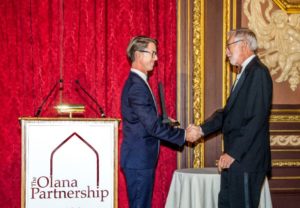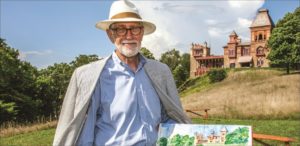“THINGS BEYOND JUST A PICTURE”

Photos by Beth Schneck Photography

by Mark Prezorski, Senior Vice President & Creative Director
In October 2017, Laurie Olin received the Frederic Church award. This was the first time a landscape architect had accepted this award, and The Olana Partnership was honored to highlight Laurie Olin’s vast accomplishments in the world of landscape architecture and the design of pubic parks. Similar to Frederic Church, Laurie Olin is an artist who also views landscapes through a civic lens. Laurie Olin is a Guggenheim Fellow, an American Academy of Rome Fellow, a Fellow of the American Society of Landscape Architects (ASLA), an honorary member of the American Institute of Architects (AIA), a Fellow of the American Academy of Arts and Sciences, and he was presented with the prestigious National Medal of Arts in 2013.
Our Frederic Church award video about Laurie Olin can be see here.
Laurie Olin has been a great friend and supporter of Olana over the years. In 2011, he was the keynote speaker in our award-winning symposium, “Framing the Viewshed: The Transformative Power of Art and Landscape in the Hudson Valley”. In 2016, Laurie’s work was featured in our design exhibition “Follies, Function & Form: Imagining Olana’s Summer House”. His concept sketch can be seen in a NY Times feature story, and Laurie can also be heard speaking about our Olana exhibition in an WAMC interview.
In preparation for our Frederic Church award film, we interviewed Laurie here at Olana earlier this year. The following is an edited transcript from that interview:
LAURIE OLIN: Olana is a much larger composition. It’s in the tradition of country villas that goes back to actually ancient Rome, but probably the thing that most Americans and others today would think of would be the English landscape garden and those great villas and houses they built in the 18th Century. This isn’t really an English landscape. This is an American landscape. But it’s also not a natural landscape.
People make a lot of mistakes. They look at it, and they see trees and grass and shrubs and they think — Oh, it’s nature. Well, those are natural elements, but the whole thing is a work of art, and the house is the centerpiece of it. It has drives, it has the forest that Frederic Church planted, it has lakes that were built, the whole thing is a vast composition done by a great visual artist in the history of American art. It’s a wonderful thing.
Church came here because of his interest in the vision of the Hudson River, which you can see. The house looks at in several different directions. There are verandas and porches that look out. Church was one of the great view painters in history. He was one of America’s greatest landscape painters, and he had studied under Thomas Cole across the river. He came here, bought this land and began developing it, and it took many decades for him to do. The drives of course had to be laid out and built, trees moved, trees planted. There was a farm. It took him a long time, and we don’t really have a lot of drawings of it because he built it in place. It’s a work of art that took many years for him to kind of elaborate, and one of the things is — if you know Church’s paintings and his sketches and great landscapes — he did a number of the Hudson River from here. There are great views from this very house. From right where I am standing there are views out across this pond below me to the Hudson. In the snow, there are views in sunset, there are views in different seasons. He was very interested in the passage of time and in nature, and the design of time. Of course, time is part of the palette of landscape architects and landscape designers.
Church — Some people would say, “Oh, he was an amateur”, but we forget that many of the greatest gardens in history were done by amateurs. They were done by people who never did another one. They only did that one. They weren’t professionals who did twelve parks or gardens. They did one great thing that they worked on for a long period of time. There is one in Britain that people know called Stourhead, done by a great banker who had people come and do things and help him. Church had people help him here. Calvert Vaux, his partner, helped with the house with certain parts and did some drawings, but this is Church’s baby. He lived here, he made it, it took him a long time, and he designed — basically it’s a studio on a hill, which is what this really is — but it’s a polychrome studio for him to have his own work and his life and his family, and it’s really an incredible total work of art.
I had known Church’s paintings, I had known Church’s landscape… I first came here a number of years ago because I knew Church’s paintings. I had always admired his drawings and paintings, especially the sketches, which I thought were quite wonderful, and so I wanted to come. So I came with my wife, and we visited, and I was just kind of blown away because, you know, it’s one thing to know a place in photographs and to know about it through literature and history. It’s another to actually walk into it and walk through it and be there and sense the spatial structure of the whole. The house is at the top, but it takes you a while to get here. It unfolds, and when I came, I thought — Oh, wonderful, the way he leads you to it, and you come behind it, and then you come through the house and come out, and there is the Hudson and the valley. It’s extraordinary. And it’s like walking into his paintings. It’s truly astonishing how you look up towards the mountains and everything, and the weather comes in, and he could see the weather coming, and he did a lot of paintings of clouds and skies in different climates, different times of year, and this was perfect — just like an observation post for him to be up here on this hilltop.
When you come here to Olana, it’s interesting because it’s one thing to see a Church painting in the Metropolitan Museum of Art, or something like the National Gallery, but when you come here, you actually see how he processed the natural information. I think for anyone who is not familiar with Church’s work or with Olana, this is quite a revelation to see the place that the work was gestated in and made. It’s also the place that inspired him, and you understand something about the difference of how he looked at things, and then he found ways to explain them through visual media, through his painting. He was trying to show us things beyond just a picture. He was trying to get us to think about time and the passage of time, was trying to get us to think about the cycles of nature and about life itself. So I think when people come here, they are quite taken by it, because I think many may make the mistake of thinking: Oh, it’s natural, this is an abandoned farm or something. It’s not. It’s a design, and it’s a composition, but it’s a painter’s composition of a world that he then could turn around and make his own work from. So it’s like doing a setup. It’s like when Cezanne sets the skull and the bottle and the things on the table. Church is a landscape painter who is setting the table with what he is doing here, with his own design of the landscape.